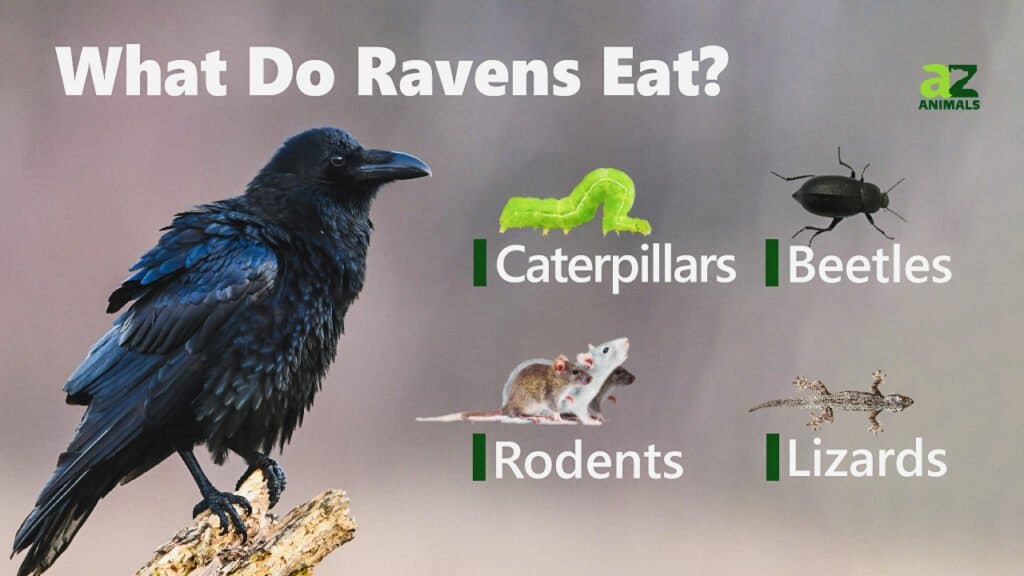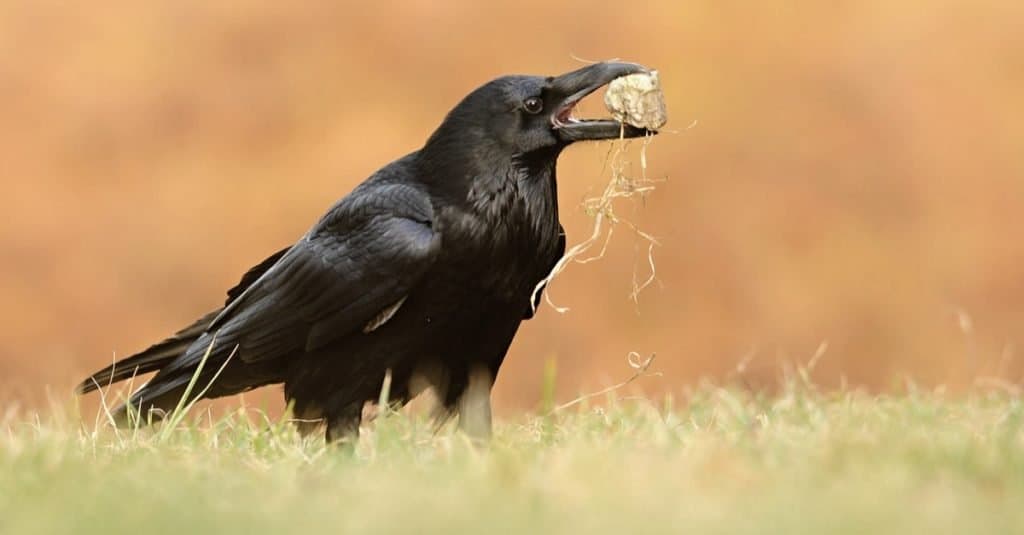The common raven (Corvus corax) is the type species of the genus Corvus and is found throughout the Northern Hemisphere. It is the largest of these birds and is known as a scavenger and predator that can live in a variety of climates, from the sweltering desert to the frigid tundra of the high Arctic.

Common ravens are huge, black birds with massive beaks. They resemble American crows, both Corvidae. They are the only other all-black North American bird species except the crow. Despite popular confusion, the two birds are unique. Ravens are four times larger and weigh more than a crow. Crows are smaller than pigeons, while ravens are larger than red-tailed hawks.
What Is a Raven’s Typical Diet?
A common raven eats anything it can get a hold of and will feast on insects, trash, carrion, seeds, fruit, and more. Its diet includes:
- Unmanaged picnics
- Trash
- Carcasses (mice and baby tortoises are examples)
- Lizards
- Frogs
- Nestlings from other birds
- Fish
- Meat (raw or cooked)
- Fruit
- Seeds
- Carrion (decaying flesh)
- Insects.
Ravens are scavengers by nature and eat a wide variety of food sources. These creatures prefer to devour decaying biomass, such as flesh or decomposing plant matter. Scavengers are vital in the food chain. Animal carcasses, or carrion, are kept out of an environment. Scavengers decompose organic matter and recycle it as nutrients back into the ecosystem.
What Are Ravens’ Favorite Foods?

Ravens certainly aren’t fussy eaters! Although, they do have some favorites, which include:
- Cat or dog food (small pellets)
- Corn
- Eggs
- Unsalted peanuts and nuts
- High protein treats (insects, smaller animals)
- Fruits
- Vegetables.
Regarding cat food, it may be a favorite of ravens, but raccoons also enjoy it. So, if you don’t want raccoons in your yard, you might want to avoid feeding this food!
For the energy they need to forage, ravens prefer to eat protein as a food source. It doesn’t matter if an animal is sick or injured if they get to eat some meat!
Where Do Ravens Hunt for Food?

Ravens are known to eat oddities such as cat food, corn, eggs, and unsalted peanuts.
©Michal Pesata/Shutterstock.com
Throughout North America, ravens can be found in large swaths of Canada and the west coast of the U.S. While they’re most common in the northeastern Chesapeake region — particularly upstate New York and West Virginia — they’re also found in the western parts of Maryland and Virginia. They enjoy deciduous and evergreen forests up to the treetops, as well as seacoasts, high deserts, sagebrush, grasslands, and tundra. Their preferred winter habitat is a cadaver or rubbish pile.
They do well in rural areas, as well as in some towns and cities. Common ravens benefit from the garbage, crops, irrigation, and roadkill they find when they live close to humans. While flying over open or partially open terrain, they wait until the ideal moment. If there is a food supply, a raven will find a way to get to it!
How Do Ravens Hunt For Food?
Common ravens are usually seen in couples or small groups, but vast numbers can develop at dumps and other food hotspots. They are intelligent and sometimes work together to flush out prey. Ravens mainly forage on the ground, but they will also raid other birds’ nests. Ravens can detect rotting carrion when flying over land. Their cries include a powerful croaking, often produced in flight.
Ravens are highly adaptable creatures. They can live in snow, desert, mountains, or woods. Common ravens eat fish, meat, seeds, fruit, carrion, and rubbish. They are not above distracting other animals and stealing their food. Ravens have few predators and have been known to live up to 40 years in captivity! The raven is clearly a clever bird that will use any available resources to fulfill its needs.
Can You Feed a Raven?

Ravens are one of the only animals known to use tools to feed.
©PhotocechCZ/Shutterstock.com
The raven has long been related to death and bad luck. It is a cursed soul reincarnated, according to the Germans. The Swedes thought a raven’s night croak was wicked. The Danish believed ravens were exorcised souls. Recent research on this unusual bird shows it is even more interesting than we thought!
Despite their dark historical and popular cultural image, a raven can be a friend. Ravens are trusting of people, often tolerating physical contact with them. The brave and playful common raven is always entertaining. On the ground, ravens strut and swagger. Ravens frequently perform aerobatics such as rapid rolls and wing-tucked dives!
Recent research shows the raven is as intellectual as dolphins and primates. For example, we now know that ravens can mimic human speech better than parrots. Common ravens are smart and can even solve problems together.
Just be wary of getting too close. A mother raven is unrelenting when protecting her young. They are usually successful in thwarting potential threats. They also won’t wait to defend themselves. If they feel threatened, a raven will lunge at predators using their large beak to attack!
How to Feed a Raven
Food is by far the most effective technique for attracting ravens! First, make sure there is nothing around that could scare the raven away, such as larger animals or something resembling this. You can then start by leaving seeds or grains. This will keep it stink-free and less likely to attract other wild animals.
The key is to leave food out consistently, so the ravens get used to a feeding schedule and are more likely to stop by and eat. Leaving the food in a somewhat open area will make it easier for ravens to spot when flying overhead. By doing this, you are allowing the raven to come to your food source, decreasing any chance of invading its space.
It is possible to gain a raven’s trust this way and enjoy the reward of watching these curious creatures. Just remember, they are wild birds and should remain so. After all, this is part of their charm!
Do Ravens Eat Small Dogs?

In most cases, Ravens do not attack small dogs.
©Cavan-Images/Shutterstock.com
Birds of prey, such as owls and hawks, will sometimes pounce upon small dogs, leaving may pet owners wary of their presence. What about ravens? Normally, ravens will not eat small dogs. Being opportunistic feeders, however, they will seize upon readily available food as the need arises. If a raven is starving, it will go after just about anything. It is possible that an unkindness (group) of ravenous ravens may go after small dogs and other small animals. So, if you see an unkindness of ravens scouting out your tiny pup, it is best to shoo them away.
Summary of Food Ravens Eat
Here’s a recap of the food that ravens commonly eat as well as their favorites:
| Number | Food |
|---|---|
| 1 | Trash |
| 2 | Unmanaged picnics |
| 3 | Carcasses (e.g. mice and baby tortoises) |
| 4 | Lizards |
| 5 | Frogs |
| 6 | Nestlings from other birds |
| 7 | Fish |
| 8 | Meat (raw or cooked) |
| 9 | Fruit |
| 10 | Seeds |
| 11 | Carrion (decaying flesh) |
| 12 | Insects |
| 13 | Cat or dog food (small pellets) |
| 14 | Corn |
| 15 | Eggs |
| 16 | Unsalted peanuts and nuts |
| 17 | High protein treats |
| 18 | Vegetables |
The photo featured at the top of this post is © iStock.com/Piotr Krzeslak
FAQs (Frequently Asked Questions)
Do Ravens Mate for Life?
Ravens are believed to mate for life and often stay in pairs in a specific area. Once they reach the age of puberty, ravens leave their parents’ nest and join the ranks of adolescent birds, much like humans! This group of juvenile birds eats, plays, and mates together until they find a mate and begin a new life together.
Thank you for reading! Have some feedback for us? Contact the AZ Animals editorial team.







